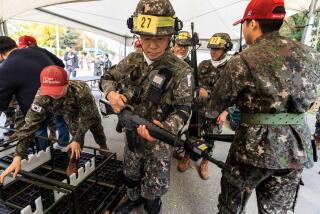POWâs Journey Home Took 50 Years
SEOUL â On Sept. 24, 2001, the South Korea armyâs âTigerâ Division gave Sgt. Kim an honor-guard ceremony, officially discharging him after counting him as killed in action for half a century.
âI couldnât tell whether it was a dream or not,â says Kim, 75, a slight, wrinkled man with a shy smile.
For Kim, it was a long journey home. When he escaped North Korea in 2001 after five decades of captivity, he was one of the last Korean War prisoners to return home from the communist North.
South Korea believes at least 400 POWs from the South may still be alive in the North. Their fate, like the war that ended in an armistice signed 50 years ago today, is unresolved.
As for American servicemen who may still be in North Korea, the U.S. government has never asserted publicly that there are any, although in 1996 a Pentagon analyst wrote in an internal report that 10 to 15 âpossible POWsâ probably were in communist captivity.
Kimâs unit was guarding South Koreaâs westernmost front line when communist invaders poured over the 38th parallel on June 25, 1950. Kim found himself âon my own, tumbling down the hills.â
By mid-October, he was among 700 POWs in an old colonial Japanese military camp in Hoeryong, a coal-mining town at North Koreaâs northeastern tip.
âWe only had one sheet of cloth we had on when we were caught. We fought over the few rice-straw mats thrown in,â Kim said. âWe starved and were so weak we had to crawl or take one step at a time leaning against the wall to go to the rest room.â
Four months later, the POWs were moved to another camp. Kim was so frail that guards left him for dead with a heap of bodies. Farmers nursed him back to life.
After the 1953 cease-fire, 8,341 South Korean POWs and 3,748 U.S. soldiers were traded for 83,000 North Koreans and Chinese.
But North Korea refused to return thousands of other South Korean prisoners, calling them âliberated soldiersâ who wanted to stay in the North. Kim knew that to ask to go home could invite punishment.
And so, he says, âI spent my next 50 years toiling at a brick kiln.â
Kim and his North Korean wife talked to the Associated Press on condition that only their last names be released, and not the name of their town, fearing for the seven children they left in the North.
When famine struck in the mid-1990s, thousands fled, including 40 POWs.
In 1995-96, 20 to 30 people died of hunger daily in Kimâs neighborhood of 20,000 people and society appeared to be breaking down. Several people were publicly executed for slaughtering orphaned children for their flesh.
Things improved around 1997 when authorities allowed farmers to cultivate their own patches instead of relying on the inefficient collective-farm system.
In March 2001, a man came to Kim and said, âYou are from the South and I know a way to get you there.â
So-called âbrokersâ smuggle people out of North Korea, bribing border guards and getting help from human rights activists and sometimes South Korean government intelligence agents, according to defectors. Seoul doesnât acknowledge a role.
Kimâs brother in Seoul financed his escape. Kim received nearly $300,000 from the South Korean government in back pay and pension, and spent about $42,000 to bring his wife out of North Korea in December.
Now Kim and his wife, Rim, want to bring an unmarried daughter to South Korea. They wish their other children could join them but realize they have families of their own.
âMy heart pounds when I think about my children and grandchildren in the North,â Rim said.
âI canât sleep very well,â said her husband.
After a half century, he is still, in a sense, a prisoner of the Korean War.
More to Read
Sign up for Essential California
The most important California stories and recommendations in your inbox every morning.
You may occasionally receive promotional content from the Los Angeles Times.










